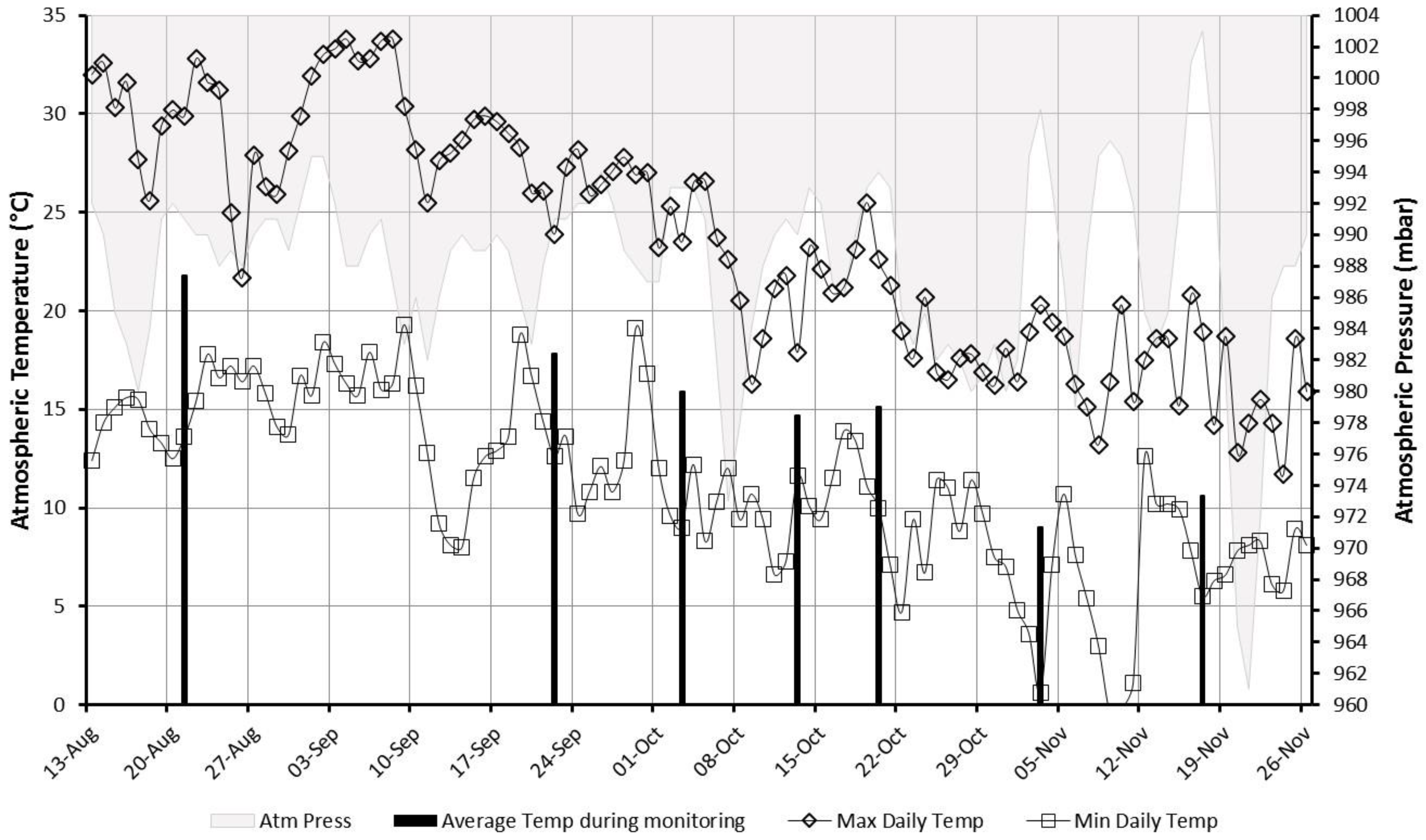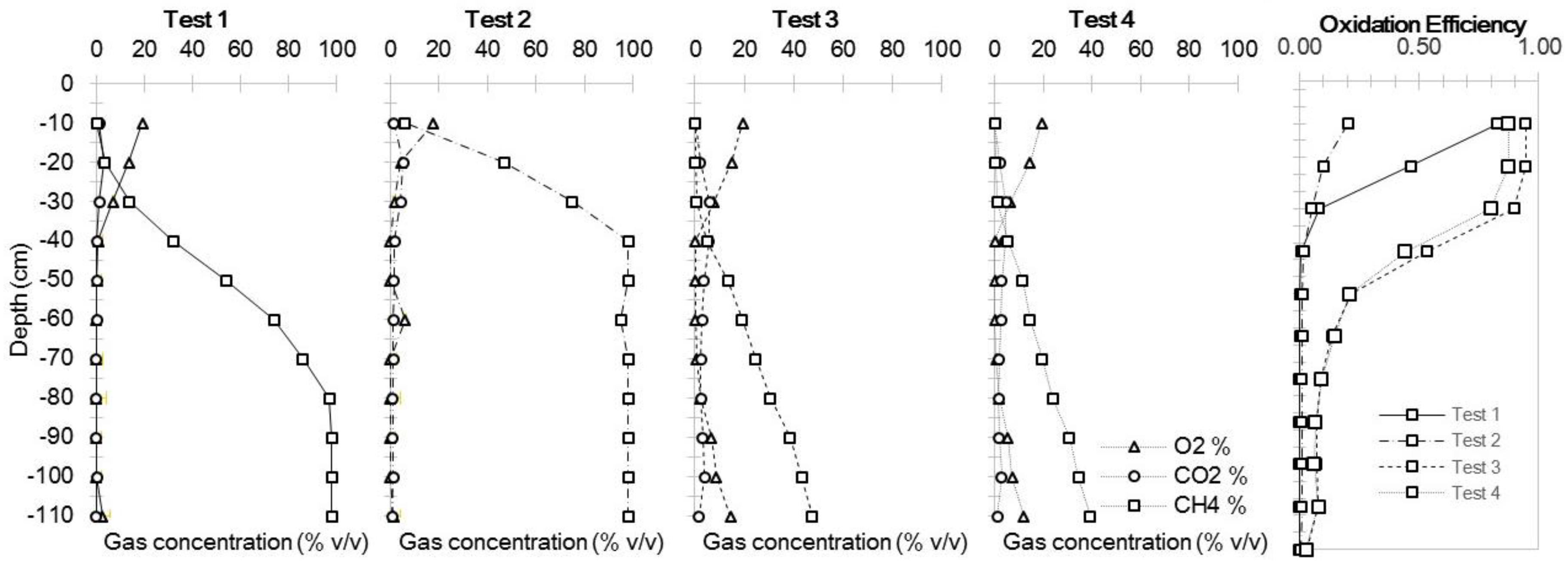Landfill GHG Reduction through Different Microbial Methane Oxidation Biocovers
Abstract
:1. Introduction
2. Materials and Methods
2.1. Description of the Site
2.2. Biocovers System Design
2.3. Column Tests
2.4. Measurement and Monitoring Program
2.5. CH4 Oxidation and Odor Mitigation Efficiencies
3. Results and Discussion
3.1. Climatic Conditions and Characteristics of the Filter Material
3.2. Gas Composition, Temperature and CH4/CO2 Ratio Profiles
3.3. CH4 Oxidation Efficiencies and Methane Emission Measurements
3.4. Column Tests
4. Conclusions
Author Contributions
Funding
Acknowledgments
Conflicts of Interest
References
- He, R.; Xia, F.-F.; Wang, J.; Pan, C.-L.; Fang, C.-R. Characterization of adsorption removal of hydrogen sulfide by waste biocover soil, an alternative landfill cover. J. Hazard. Mater. 2011, 186, 773–778. [Google Scholar] [CrossRef] [PubMed]
- Global Warming Potentials (IPCC Second Assessment Report)|UNFCCC. Available online: https://unfccc.int/process/transparency-and-reporting/greenhouse-gas-data/greenhouse-gas-data-unfccc/global-warming-potentials (accessed on 31 March 2020).
- Waste Statistics—Statistics Explained. Available online: https://ec.europa.eu/eurostat/statistics-explained/index.php?title=Waste_statistics (accessed on 31 March 2020).
- Pecorini, I.; Baldi, F.; Bacchi, D.; Carnevale, E.A.; Corti, A. Leaching behaviour of hazardous waste under the impact of different ambient conditions. Waste Manag. 2017, 63, 96–106. [Google Scholar] [CrossRef] [PubMed]
- ISPRA: Catasto Nazionale Rifiuti. Available online: https://www.catasto-rifiuti.isprambiente.it/index.php?pg=&width=1920&height=1080 (accessed on 31 March 2020).
- Rettenberger, G. Collection and Disposal of Landfill Gas. In Solid Waste Landfilling; Elsevier: Amsterdam, The Netherlands, 2018; pp. 449–462. ISBN 978-0-12-818336-6. [Google Scholar]
- Sadasivam, B.Y.; Reddy, K.R. Landfill methane oxidation in soil and bio-based cover systems: A review. Rev. Environ. Sci. Biotechnol. 2014, 13, 79–107. [Google Scholar] [CrossRef]
- Bacchi, D.; Bacci, R.; Ferrara, G.; Lombardi, L.; Pecorini, I.; Rossi, E. Life Cycle Assessment (LCA) of landfill gas management: Comparison between conventional technologies and microbial oxidation systems. Energy Procedia 2018, 148, 1066–1073. [Google Scholar] [CrossRef]
- Rettenberger, G. Utilization of Landfill Gas and Safety Measures. In Solid Waste Landfilling; Elsevier: Amsterdam, The Netherlands, 2018; pp. 463–476. ISBN 978-0-12-818336-6. [Google Scholar]
- Lombardi, L.; Carnevale, E.A.; Pecorini, I. Experimental evaluation of two different types of reactors for CO2 removal from gaseous stream by bottom ash accelerated carbonation. Waste Manag. 2016, 58, 287–298. [Google Scholar] [CrossRef] [PubMed]
- Felske, C.; Haubrichs, R.; Widmann, R. Engineering strategies for efficient methane oxidation in landfill cover liners and biofilter systems. In Proceedings of the Sardinia 2005. Tenth International Waste Management and Landfill Symposium, S. Margherita di Pula, Cagliari, Italy, 3–7 October 2005. [Google Scholar]
- Pecorini, I.; Bacchi, D.; Ferrara, G.; Rossi, E.; Caselli, R.L.; Zipoli, L.; Menghetti, F. Biofiltration prototyes for methane oxidation in landfill aftercare and abatement of NMVOCs and odorous compounds. Procedia Environ. Sci. Eng. Manag. 2017, 4, 173–181. [Google Scholar]
- Rossi, E.; Pecorini, I.; Iannelli, R. Risk assessment of a methane oxidizing biofilter for reducing landfill gas emissions from a post-closure landfill. Procedia Environ. Sci. Eng. Manag. 2019, 6, 209–219. [Google Scholar]
- Gebert, J.; Röwer, I.U.; Scharff, H.; Roncato, C.D.L.; Cabral, A.R. Can soil gas profiles be used to assess microbial CH4 oxidation in landfill covers? Waste Manag. 2011, 31, 987–994. [Google Scholar] [CrossRef]
- Cassini, F.; Scheutz, C.; Skov, B.H.; Mou, Z.; Kjeldsen, P. Mitigation of methane emissions in a pilot-scale biocover system at the AV Miljø Landfill, Denmark: 1. System design and gas distribution. Waste Manag. 2017, 63, 213–225. [Google Scholar] [CrossRef] [Green Version]
- Capanema, M.A.; Cabana, H.; Cabral, A.R. Reduction of odours in pilot-scale landfill biocovers. Waste Manag. 2014, 34, 770–779. [Google Scholar] [CrossRef]
- Jung, H.; Oh, K.-C.; Ryu, H.-W.; Jeon, J.-M.; Cho, K.-S. Simultaneous mitigation of methane and odors in a biowindow using a pipe network. Waste Manag. 2019, 100, 45–56. [Google Scholar] [CrossRef] [PubMed]
- Scheutz, C.; Kjeldsen, P.; Bogner, J.E.; De Visscher, A.; Gebert, J.; Hilger, H.A.; Huber-Humer, M.; Spokas, K. Microbial methane oxidation processes and technologies for mitigation of landfill gas emissions. Waste Manag. Res. 2009, 27, 409–455. [Google Scholar] [CrossRef] [PubMed]
- Pecorini, I.; Rossi, E.; Iannelli, R. Mitigation of Methane, NMVOCs and Odor Emissions in Active and Passive Biofiltration Systems at Municipal Solid Waste Landfills. Sustainability 2020, 12, 3203. [Google Scholar] [CrossRef] [Green Version]
- Pecorini, I.; Albini, E.; Rossi, E.; Iannelli, R.; Raco, B.; Lippo, G. Landfill mining: A case study on characterization of excavated waste. Procedia Environ. Sci. Eng. Manag. 2018, 5, 153–158. [Google Scholar]
- Rossi, E.; Pecorini, I.; Iannelli, R. Methane oxidation of residual landfill gas in a full-scale biofilter: Human health risk assessment of volatile and malodours compound emissions. Environ. Sci. Pollut. Res. 2020, 1–13. [Google Scholar] [CrossRef] [PubMed]
- Einola, J.-K.M.; Karhu, A.E.; Rintala, J.A. Mechanically–biologically treated municipal solid waste as a support medium for microbial methane oxidation to mitigate landfill greenhouse emissions. Waste Manag. 2008, 28, 97–111. [Google Scholar] [CrossRef]
- Gebert, J.; Groengroeft, A.; Miehlich, G. Kinetics of microbial landfill methane oxidation in biofilters. Waste Manag. 2003, 23, 609–619. [Google Scholar] [CrossRef]
- Borjesson, G.; Sundh, I.; Svensson, B. Microbial oxidation of CH4 at different temperatures in landfill cover soils. FEMS Microbiol. Ecol. 2004, 48, 305–312. [Google Scholar] [CrossRef]
- Mor, S.; De Visscher, A.; Ravindra, K.; Dahiya, R.P.; Chandra, A.; Van Cleemput, O. Induction of enhanced methane oxidation in compost: Temperature and moisture response. Waste Manag. 2006, 26, 381–388. [Google Scholar] [CrossRef] [Green Version]
- Einola, J.-K.M.; Kettunen, R.H.; Rintala, J.A. Responses of methane oxidation to temperature and water content in cover soil of a boreal landfill. Soil Biol. Biochem. 2007, 39, 1156–1164. [Google Scholar] [CrossRef]
- Rossi, E.; Frasi, N.; Pecorini, I.; Ferrara, G. Methane oxidation efficiency and NMVOCs reduction in a full-scale passive bioifltration system for the treatment of residual landfill gas. Procedia Environ. Sci. Eng. Manag. 2018, 5, 147–152. [Google Scholar]
- Roncato, C.D.; Létourneau, M.; Cabral, A.R. Comparison between Field and Laboratory Methane Oxidation Rates. In Proceedings of the GeoFlorida 2010; American Society of Civil Engineers: Orlando, FL, USA, 2010; pp. 2906–2915. [Google Scholar]
- Scheutz, C.; Pedersen, R.B.; Petersen, P.H.; Jørgensen, J.H.B.; Ucendo, I.M.B.; Mønster, J.G.; Samuelsson, J.; Kjeldsen, P. Mitigation of methane emission from an old unlined landfill in Klintholm, Denmark using a passive biocover system. Waste Manag. 2014, 34, 1179–1190. [Google Scholar] [CrossRef] [PubMed]
- Chan, A.S.K.; Parkin, T.B. Evaluation of potential inhibitors of methanogenesis and methane oxidation in a land®ll cover soil. Soil Biol. Biochem. 2000, 32, 1581–1590. [Google Scholar] [CrossRef]
- Wilshusen, J.H.; Hettiaratchi, J.P.A.; De Visscher, A.; Saint-Fort, R. Methane oxidation and formation of EPS in compost: Effect of oxygen concentration. Environ. Pollut. 2004, 129, 305–314. [Google Scholar] [CrossRef] [PubMed]
- Pecorini, I.; Iannelli, R. Characterization of Excavated Waste of Different Ages in View of Multiple Resource Recovery in Landfill Mining. Sustainability 2020, 12, 1780. [Google Scholar] [CrossRef] [Green Version]
- Barbusinski, K.; Kalemba, K.; Kasperczyk, D.; Urbaniec, K.; Kozik, V. Biological methods for odor treatment—A review. J. Clean. Prod. 2017, 152, 223–241. [Google Scholar] [CrossRef]
- Liu, Y.; Lu, W.; Wang, H.; Huang, Q.; Gao, X. Odor impact assessment of trace sulfur compounds from working faces of landfills in Beijing, China. J. Environ. Manag. 2018, 220, 136–141. [Google Scholar] [CrossRef]
- Dever, S.; Swarbrick, G.E.; Stuetz, R.M. (19) (PDF) Handbook for the Design, Construction, Operation, Monitoring and Maintenance of a Passive Landfill Gas Drainage and Biofiltration System. Available online: https://www.researchgate.net/publication/239998633_Handbook_for_the_design_construction_operation_monitoring_and_maintenance_of_a_passive_landfill_gas_drainage_and_biofiltration_system (accessed on 20 March 2020).
- Dever, S.A.; Swarbrick, G.E.; Stuetz, R.M. Passive drainage and biofiltration of landfill gas: Australian field trial. Waste Manag. 2007, 27, 277–286. [Google Scholar] [CrossRef] [PubMed]
- Majdinasab, A.; Yuan, Q. Performance of the biotic systems for reducing methane emissions from landfill sites: A review. Ecol. Eng. 2017, 104, 116–130. [Google Scholar] [CrossRef]
- EUR-Lex—31999L0031—EN. Available online: https://eur-lex.europa.eu/legal-content/EN/TXT/HTML/?uri=CELEX:31999L0031&from=EN (accessed on 29 April 2020).
- Jugnia, L.-B.; Cabral, A.R.; Greer, C.W. Biotic methane oxidation within an instrumented experimental landfill cover. Ecol. Eng. 2008, 33, 102–109. [Google Scholar] [CrossRef]
- Adani, F.; Ubbiali, C.; Generini, P. The determination of biological stability of composts using the Dynamic Respiration Index: The results of experience after two years. Waste Manag. 2006, 26, 41–48. [Google Scholar] [CrossRef] [PubMed]
- Albini, E.; Pecorini, I.; Ferrara, G. Evaluation of biological processes performances using different stability indices. Procedia Environ. Sci. Eng. Manag. 2019, 6, 1–10. [Google Scholar]
- Baldi, F.; Iannelli, R.; Pecorini, I.; Polettini, A.; Pomi, R.; Rossi, A. Influence of the pH control strategy and reactor volume on batch fermentative hydrogen production from the organic fraction of municipal solid waste. Waste Manag. Res. 2019, 37, 478–485. [Google Scholar] [CrossRef] [PubMed] [Green Version]
- Baldi, F.; Pecorini, I.; Iannelli, R. Comparison of single-stage and two-stage anaerobic co-digestion of food waste and activated sludge for hydrogen and methane production. Renew. Energy 2019, 143, 1755–1765. [Google Scholar] [CrossRef]
- Pecorini, I. Sistemi di Monitoraggio Delle Emissioni Diffuse di Biogas di Discarica per la Ottimizzazione del Sistema di Gestione. Ph.D. Thesis, Università Degli Studi di Firenze, Firenze, Italy, 2010. [Google Scholar]
- Raco, B.; Battaglini, R.; Lelli, M. Gas emission into the atmosphere from controlled landfills: An example from Legoli landfill (Tuscany, Italy). Environ. Sci. Pollut. Res. 2010, 17, 1197–1206. [Google Scholar] [CrossRef]
- Thomasen, T.B.; Scheutz, C.; Kjeldsen, P. Treatment of landfill gas with low methane content by biocover systems. Waste Manag. 2019, 84, 29–37. [Google Scholar] [CrossRef]
- Scheutz, C.; Cassini, F.; De Schoenmaeker, J.; Kjeldsen, P. Mitigation of methane emissions in a pilot-scale biocover system at the AV Miljø Landfill, Denmark: 2. Methane oxidation. Waste Manag. 2017, 63, 203–212. [Google Scholar] [CrossRef] [Green Version]
- Huber-Humer, M.; Gebert, J.; Hilger, H. Biotic systems to mitigate landfill methane emissions. Waste Manag. Res. 2008, 26, 33–46. [Google Scholar] [CrossRef]
- Huber-Humer, M.; Tintner, J.; Böhm, K.; Lechner, P. Scrutinizing compost properties and their impact on methane oxidation efficiency. Waste Manag. 2011, 31, 871–883. [Google Scholar] [CrossRef]







© 2020 by the authors. Licensee MDPI, Basel, Switzerland. This article is an open access article distributed under the terms and conditions of the Creative Commons Attribution (CC BY) license (http://creativecommons.org/licenses/by/4.0/).
Share and Cite
Pecorini, I.; Iannelli, R. Landfill GHG Reduction through Different Microbial Methane Oxidation Biocovers. Processes 2020, 8, 591. https://doi.org/10.3390/pr8050591
Pecorini I, Iannelli R. Landfill GHG Reduction through Different Microbial Methane Oxidation Biocovers. Processes. 2020; 8(5):591. https://doi.org/10.3390/pr8050591
Chicago/Turabian StylePecorini, Isabella, and Renato Iannelli. 2020. "Landfill GHG Reduction through Different Microbial Methane Oxidation Biocovers" Processes 8, no. 5: 591. https://doi.org/10.3390/pr8050591





